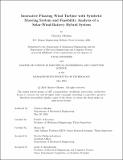Innovative Floating Wind Turbine with Synthetic Mooring System and Feasibility Analysis of a Solar-Wind-Battery Hybrid System
Author(s)
Gkiokas, Christos
DownloadThesis PDF (13.22Mb)
Advisor
Sclavounos, Paul D.
Ilic, Marija
Terms of use
Metadata
Show full item recordAbstract
Synthetic mooring lines, characterized by their neutral buoyancy and high strength, are crucial for maintaining the station-keeping of Floating Wind Turbines (FWTs) by providing the necessary restoring forces while minimizing the vertical loads on the platform. This thesis explores the evolution of mooring systems from traditional catenary chains to taut synthetic fiber ropes, using the VolturnUS-S semi-submersible platform as a case study. The investigation delves into the viscoelastic properties of synthetic ropes and the challenges in accurately modeling their stiffness characteristics. Detailed analysis of the mooring system for the VolturnUS-S platform includes configuration, inclination, and composition of the mooring lines. Environmental conditions at the prospective mooring site are analyzed to evaluate the platform’s responses. A mesh sensitivity study determines the optimal balance between computational efficiency and accuracy. Various stiffness models of polyester mooring ropes are compared, highlighting the impact of rope diameter and inclination on mooring system performance, examining pretension, static and dynamic tensions, and safety margins. The major conclusions of this study are discussed, emphasizing the key findings. Acomprehensive feasibility analysis and preliminary economic assessment of a solar-windbattery hybrid system designed to supply power to a remote island is presented. Multiple configurations are evaluated to identify the most cost-effective and efficient system. The findings indicate that a hybrid system is both technically viable and economically feasible, with wind energy contributing significantly during winter months and solar energy during summer, yielding a reliable power supply throughout the year. Additionally, an overview of offshore wind submarine cabling is provided, focusing on types of cables, route planning, installation, operational considerations, and environmental impacts. Comprehensive planning for cable routes is covered, including site assessments, hydrographic surveys, and regulatory requirements.
Date issued
2024-05Department
Massachusetts Institute of Technology. Department of Electrical Engineering and Computer Science; Massachusetts Institute of Technology. Department of Mechanical EngineeringPublisher
Massachusetts Institute of Technology